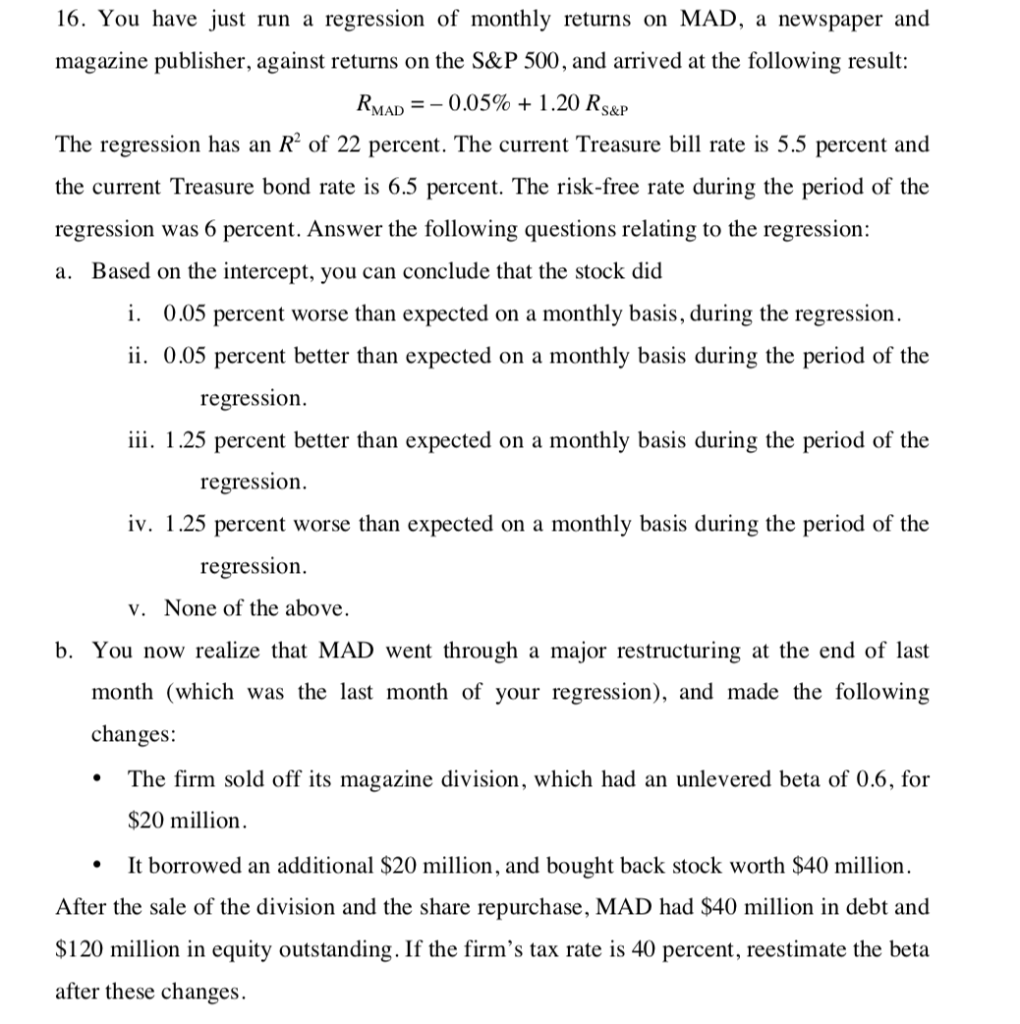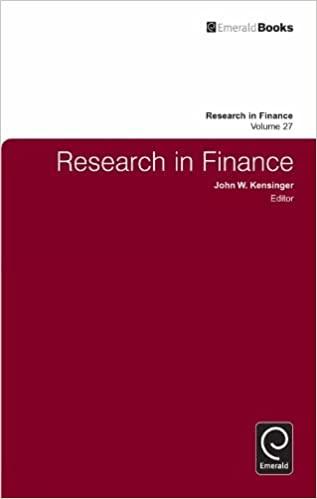 16. You have just run a regression of monthly returns on MAD, a newspaper and magazine publisher, against returns on the S&P 500, and arrived at the following result: RMAD = 0.05% + 1.20 RS&P The regression has an R2 of 22 percent. The current Treasure bill rate is 5.5 percent and the current Treasure bond rate is 6.5 percent. The risk-free rate during the period of the regression was 6 percent. Answer the following questions relating to the regression: a. Based on the intercept, you can conclude that the stock did i. 0.05 percent worse than expected on a monthly basis, during the regression. ii. 0.05 percent better than expected on a monthly basis during the period of the regression. iii. 1.25 percent better than expected on a monthly basis during the period of the regression. iv. 1.25 percent worse than expected on a monthly basis during the period of the regression. v. None of the above. b. You now realize that MAD went through a major restructuring at the end of last month (which was the last month of your regression), and made the following changes: The firm sold off its magazine division, which had an unlevered beta of 0.6, for $20 million. It borrowed an additional $20 million, and bought back stock worth $40 million. After the sale of the division and the share repurchase, MAD had $40 million in debt and $120 million in equity outstanding. If the firms tax rate is 40 percent, reestimate the beta after these changes.
16. You have just run a regression of monthly returns on MAD, a newspaper and magazine publisher, against returns on the S&P 500, and arrived at the following result: RMAD = 0.05% + 1.20 RS&P The regression has an R2 of 22 percent. The current Treasure bill rate is 5.5 percent and the current Treasure bond rate is 6.5 percent. The risk-free rate during the period of the regression was 6 percent. Answer the following questions relating to the regression: a. Based on the intercept, you can conclude that the stock did i. 0.05 percent worse than expected on a monthly basis, during the regression. ii. 0.05 percent better than expected on a monthly basis during the period of the regression. iii. 1.25 percent better than expected on a monthly basis during the period of the regression. iv. 1.25 percent worse than expected on a monthly basis during the period of the regression. v. None of the above. b. You now realize that MAD went through a major restructuring at the end of last month (which was the last month of your regression), and made the following changes: The firm sold off its magazine division, which had an unlevered beta of 0.6, for $20 million. It borrowed an additional $20 million, and bought back stock worth $40 million. After the sale of the division and the share repurchase, MAD had $40 million in debt and $120 million in equity outstanding. If the firms tax rate is 40 percent, reestimate the beta after these changes.
16. You have just run a regression of monthly returns on MAD, a newspaper and magazine publisher, against returns on the S&P 500, and arrived at the following result: Road = 0.05% + 1.20 Rs&P The regression has an R2 of 22 percent. The current Treasure bill rate is 5.5 percent and the current Treasure bond rate is 6.5 percent. The risk-free rate during the period of the regression was 6 percent. Answer the following questions relating to the regression: a. Based on the intercept, you can conclude that the stock did i. 0.05 percent worse than expected on a monthly basis, during the regression. ii. 0.05 percent better than expected on a monthly basis during the period of the regression. iii. 1.25 percent better than expected on a monthly basis during the period of the regression. iv. 1.25 percent worse than expected on a monthly basis during the period of the regression. V. None of the above. b. You now realize that MAD went through a major restructuring at the end of last month (which was the last month of your regression), and made the following changes: The firm sold off its magazine division, which had an unlevered beta of 0.6, for $20 million. It borrowed an additional $20 million, and bought back stock worth $40 million. After the sale of the division and the share repurchase, MAD had $40 million in debt and $120 million in equity outstanding. If the firm's tax rate is 40 percent, reestimate the beta after these changes. 16. You have just run a regression of monthly returns on MAD, a newspaper and magazine publisher, against returns on the S&P 500, and arrived at the following result: Road = 0.05% + 1.20 Rs&P The regression has an R2 of 22 percent. The current Treasure bill rate is 5.5 percent and the current Treasure bond rate is 6.5 percent. The risk-free rate during the period of the regression was 6 percent. Answer the following questions relating to the regression: a. Based on the intercept, you can conclude that the stock did i. 0.05 percent worse than expected on a monthly basis, during the regression. ii. 0.05 percent better than expected on a monthly basis during the period of the regression. iii. 1.25 percent better than expected on a monthly basis during the period of the regression. iv. 1.25 percent worse than expected on a monthly basis during the period of the regression. V. None of the above. b. You now realize that MAD went through a major restructuring at the end of last month (which was the last month of your regression), and made the following changes: The firm sold off its magazine division, which had an unlevered beta of 0.6, for $20 million. It borrowed an additional $20 million, and bought back stock worth $40 million. After the sale of the division and the share repurchase, MAD had $40 million in debt and $120 million in equity outstanding. If the firm's tax rate is 40 percent, reestimate the beta after these changes
 16. You have just run a regression of monthly returns on MAD, a newspaper and magazine publisher, against returns on the S&P 500, and arrived at the following result: RMAD = 0.05% + 1.20 RS&P The regression has an R2 of 22 percent. The current Treasure bill rate is 5.5 percent and the current Treasure bond rate is 6.5 percent. The risk-free rate during the period of the regression was 6 percent. Answer the following questions relating to the regression: a. Based on the intercept, you can conclude that the stock did i. 0.05 percent worse than expected on a monthly basis, during the regression. ii. 0.05 percent better than expected on a monthly basis during the period of the regression. iii. 1.25 percent better than expected on a monthly basis during the period of the regression. iv. 1.25 percent worse than expected on a monthly basis during the period of the regression. v. None of the above. b. You now realize that MAD went through a major restructuring at the end of last month (which was the last month of your regression), and made the following changes: The firm sold off its magazine division, which had an unlevered beta of 0.6, for $20 million. It borrowed an additional $20 million, and bought back stock worth $40 million. After the sale of the division and the share repurchase, MAD had $40 million in debt and $120 million in equity outstanding. If the firms tax rate is 40 percent, reestimate the beta after these changes.
16. You have just run a regression of monthly returns on MAD, a newspaper and magazine publisher, against returns on the S&P 500, and arrived at the following result: RMAD = 0.05% + 1.20 RS&P The regression has an R2 of 22 percent. The current Treasure bill rate is 5.5 percent and the current Treasure bond rate is 6.5 percent. The risk-free rate during the period of the regression was 6 percent. Answer the following questions relating to the regression: a. Based on the intercept, you can conclude that the stock did i. 0.05 percent worse than expected on a monthly basis, during the regression. ii. 0.05 percent better than expected on a monthly basis during the period of the regression. iii. 1.25 percent better than expected on a monthly basis during the period of the regression. iv. 1.25 percent worse than expected on a monthly basis during the period of the regression. v. None of the above. b. You now realize that MAD went through a major restructuring at the end of last month (which was the last month of your regression), and made the following changes: The firm sold off its magazine division, which had an unlevered beta of 0.6, for $20 million. It borrowed an additional $20 million, and bought back stock worth $40 million. After the sale of the division and the share repurchase, MAD had $40 million in debt and $120 million in equity outstanding. If the firms tax rate is 40 percent, reestimate the beta after these changes.





